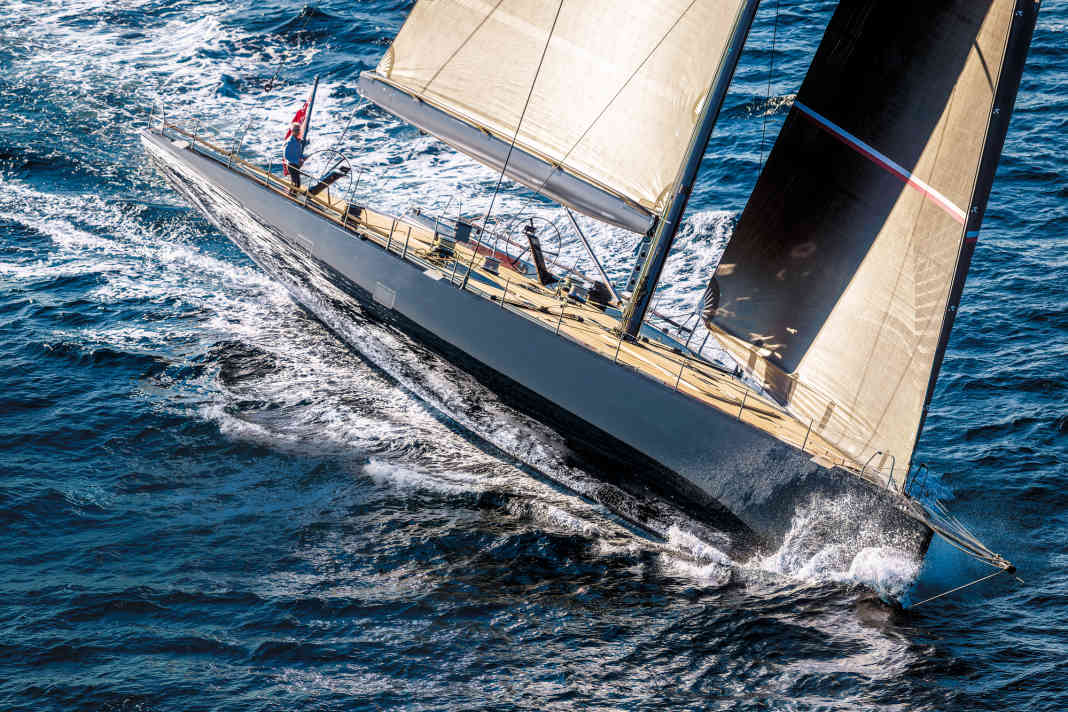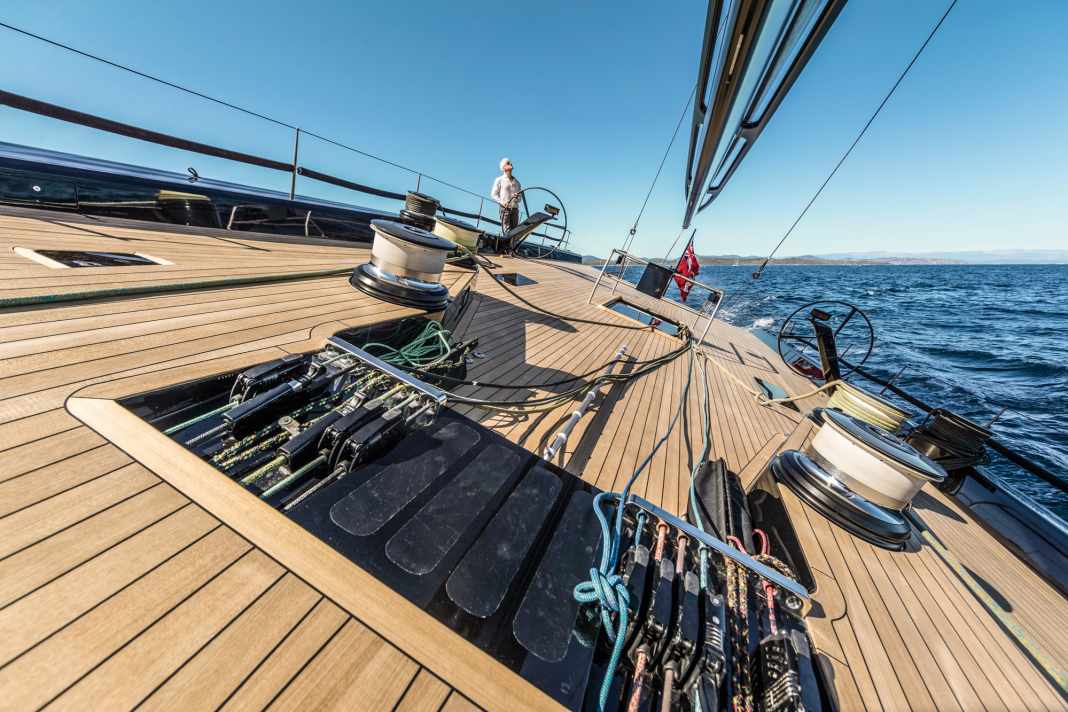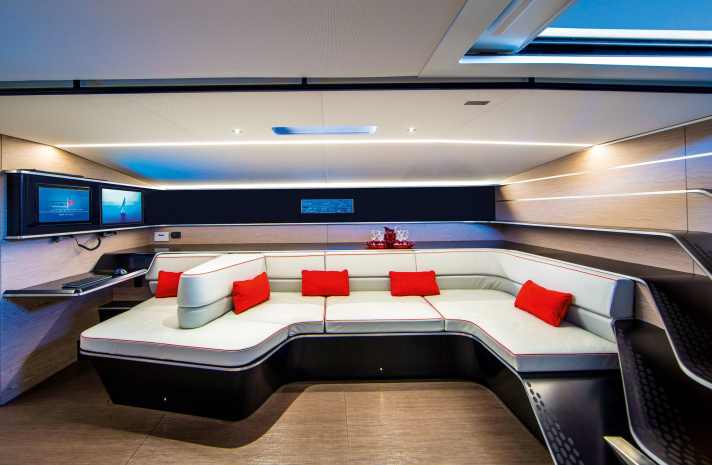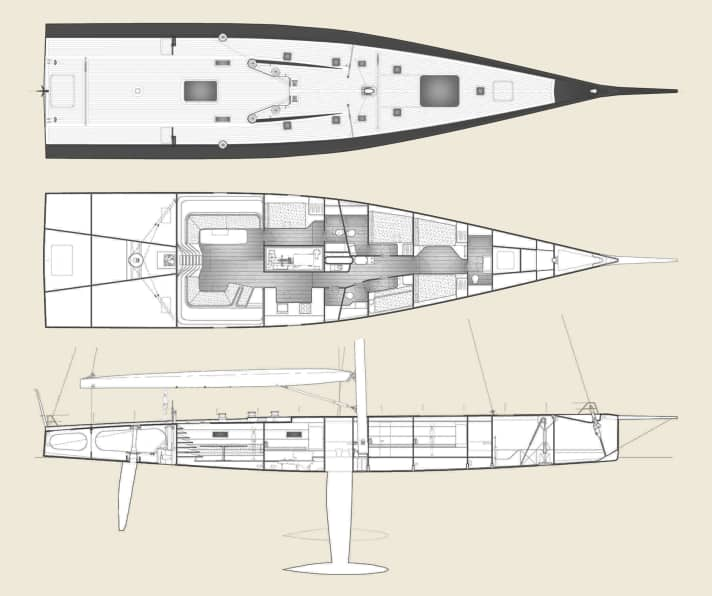"Wally Tango": Italian haute couture sailing yacht without any stumbling blocks
Friedrich W. Pohl
· 10.04.2023






It's hard not to love Wally. At least for those who have a heart and at least an eye for what is probably the most minimalist design of fast sailing yachts from 24 metres upwards currently available. In 1994, Wally set out not to fill a gap in the market, but to create a market of its own: fast sailing yachts with unmistakable Italian styling.
Luca Bassani Antivari, the inventor and founder of the Wally brand, once again proclaimed his mantra at the premiere of the 30-metre-long Wallycento "Tango": the DNA of Wally cruisers/racers is "beautiful and super-fast". The man behind the Italian haute couture of sailing yachts christened the 100-foot class of his brand "Wallycento". "Tango", says Bassani about the first dancing steps of his new ballerina, is a further evolutionary step for high-performance superyachts, which benefits from its three predecessors. This makes it clear that the brand choreographer Bassani is not freezing the development of the Wallycentos in a strict standardised class. Each new Wallycento owner stands with his improvements as a dwarf on the shoulders of a giant, namely on the experience of the previous cento owners. Before "Tango", Bassani's Wallycento ensemble included three 100-series slips: "Open Season" (Thomas Bscher, design: Judel/Vrolijk, 2012), "Magic Carpet 3" (Sir Lindsay Owen Jones, design: Reichel/Pugh, 2013) and "Galateia" (Switchback Marine, Reichel/Pugh, 2015).
The "Tango" was designed by Mark Mills
Mark Mills' design office on the Irish east coast, a little further south of Dublin, drew the outline and architecture of "Tango". The designer was delighted to be able to find new solutions in terms of "speed and beauty" thanks to an imaginative owner and Bassani's driving force. It was clear that the fruits of his ideas would not be easy to come by "in a class that is already so aggressive in its approach", according to Mills. In addition to the hull lines, Mills concentrated on the rudder and keel appendages and on reducing the weight of materials and technical systems, centralising the interior and making the rig adjustment more dynamic. In addition, the deck was ergonomically designed to simplify crew manoeuvres. "The jib is set in six seconds," says Bassani, delighted with the result. These improvements also had consequences for the lines above the water, namely a reverse jump: at the height of the mast, the freeboard overhangs the bow and stern. In addition, the cockpit merges into the foredeck completely free of tripping hazards, "practical answers to technical developments", says Mills. His designers ironed the "Tango" deck as smooth as a surfboard. "The visual rigour is overwhelming," says Mills, praising the result.



The "ramp deck", as he calls it, allows an uninterrupted line from bow to stern: "Sensational!" This not only helps the crew with manoeuvres, but also makes the construction stronger. This design with convincing deck geometry also offers the opportunity to place the centre of gravity of the interior fittings at the lowest point of the hull.
Combining these innovations all at once in a new project was not entirely risk-free. "But now that she's sailing, I'm thrilled at how successfully the new elements have been integrated." On the port and starboard sides, a bulwark just under knee-high provides support, as on the 45-metre-long Wally "Esense". The mercilessly consistent flush deck style is complemented by powerful Harken hardware.
Interior by Pininfarina ensures agility
Last but not least, the effortlessness of the Pininfarina interior also ensures agility, but "the boat speed causes impressive hull noises in contact with water due to the bare carbon housing below deck," says BOOTE-EXCLUSIV editor-in-chief Martin Hager, who has already had "Tango" under his feet and in his hands.
Together with the Monegasque project management MYT and the Mills designers, not only the designers from Pininfarina but also the Italian shipyard Persico Marine in Nembro near Bergamo dedicated themselves to completing the "Tango".
Wally worked with the last three for the first time. The designers of Pininfarina, with their famous automotive tradition, not least at Ferrari, share the automotive commitment with Persico. In addition to automotive and marine contracts, the Persico Group also works worldwide for the aviation industry, in the USA, China and Mexico, with designers, engineering services and production facilities. CEO Marcello Persico had qualified with his shipyard through his Volvo Ocean Racer for the 2017 race, mini maxi entries and AC catamaran platforms and wings. "We are delighted with our collaboration with Persico Marine," praises Bassani. "Persico complemented our 20 years of expertise. 'Tango' is characterised by its feather-light strength."
The owner gave the go-ahead for these collaborations "with a briefing on the combination of sailing performance and style," explains Bassani. As an experienced regatta sailor himself, he knows how important visual appeal is. Speed alone is not enough. He is proud of how Wally combines form and function with "Tango".
Wally DNA not to be overlooked
Incidentally, the Mills designers took the surfboard deck from the deck of their Maxi 72 "Alegre", built in 2013. "Tango" thus combines genes from "Alegre" and "Esense", "a reflection of the Wally DNA in terms of improved functionality", says Bassani. Pininfarina, he continues enthusiastically, was the ideal partner to marry the pure "Tango" sportiness with the stylish superyacht character of the interior. The visionary owner was immediately in favour of integrating the Italian design studio. He followed the advice of Marcello Persico, who had already gained long and fruitful experience with Pininfarina in the automotive industry. "Right from the start, we at Wally were always open to new partners in project development," says Bassani. Input from outside is important. Pininfarina was very successful in the very special "Tango" task of maintaining consistency in the design of the interior and exterior.

The owner and Wally commissioned the MYT office, Monaco Yacht Temptation, which is familiar with the Wally world, to formulate the design principles and coordinate the project. "The 'Tango' development owes its success not least to Carlo Torre and his team," says Bassani, praising his neighbours in Monaco from Boulevard Albert I.
And how does "Wally Tango" feel on the road?
It is balanced on the rudder and reacts quickly, enthuses Bassani. "Radical racing machine with an incredible amount of power" was Hager's impression of the KCrbon design during his time on the beautifully shaped "Tango" bike. "The almost four metre long carbon dagger under the rear builds up a powerful rudder pressure." This has consequences for the power nature of the helmsman. "Two-finger steering is not possible", and that in light winds on the test day. Hager would give his Wallycento a twin rudder: "More sensitive." In other words: "Tango" requires the whole helmsman in the fight.
Hager can confirm the fast response: "Thanks to the displacement of just 47 tonnes, it starts up quickly." And this quick start has an effect on the "Tango" speed. "She runs at an easy eight knots in very light winds and ten knots in light gusts." If the wind is stronger, the VPP forecasts predict exhilarating surfing interludes.
A performance slup like "Tango" craves regattas. The Wallys have been sailing in their own class for years, and not just in the Maxi Yacht Rolex Cup. In 2018, the fast cruisers/racers met in May off Palma de Mallorca for the Palmavela, in June off Saint-Tropez for the Giraglia Rolex Cup, in September for the Maxi Rolex Cup off Porto Cervo and at the end of September for the Voiles de Saint-Tropez.
Within the Wallys themselves, the youngest Wallycento "Galateia" came out on top in September 2017: two first and two second places in six races. That was enough for the overall victory among eleven Wallys. We will know how "Tango" will fare against "Galateia" in six months' time at the latest.
Technical data
- Length over everything: 30,48 m
- Width: 7,20 m
- Depth: 4.40 m, 6.20 m
- Displacement: 47,5 t
- Material:Prepreg carbon fibres
- Rig: Southern Spars
- Hardware Deck:Rake
- Mast above deck: 45 m
- Sail area on the wind:640 m²
- Sail area on the centreboard: 1.398 m²
- Motor:VM MR706LX, 260 kW
- Generator: Fischer Panda 15000i
- Fuel: 1.500 l
- Water: 2.000 l
- Navigation: B&G Zeus 3
- Construction:Mills Design
- Styling:Wally, Mills Design
- Interior:Pininfarina
- Classification: DNV GL
- Shipyard: Persico Marine, 2017


